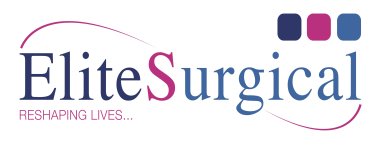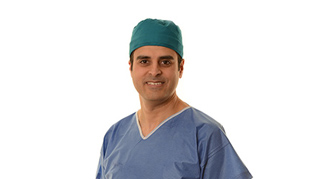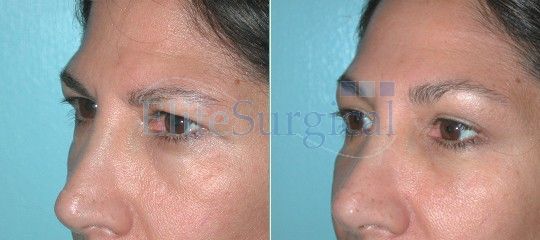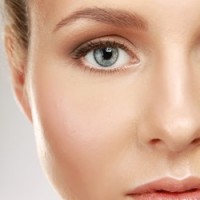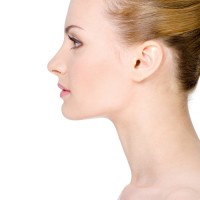Brow Lift (Forehead Lift or Browplasty)
A brow lift is an elective cosmetic surgery procedure performed to elevate the brow, which has descended due to aging. Often, the first signs of aging are in the brow and forehead, where the skin has lost elasticity, resulting in frown lines, wrinkling across the forehead and heaviness in the eyebrows. Even younger patients in their 30’s can have faces that appear older than their true age and can benefit from a brow lift. A Forehead Reduction procedure is also commonly combined with a brow lift.
Hairline Lowering Surgery, also known as Forehead Reduction, is used to enhance the forehead and facial appearance through repositioning the hairline to pronounce facial and feminine features. A forehead that is too large and out of proportion with the other facial feature can be corrected by Forehead Lowering Plastic surgery or Hairline advancement, to provide a more natural forehead and hairline shape. In repositioning the hairline, an incision is made at the front of the hairline extending from just in front of the ear/temple areas on each side to meet at the top of the forehead just at the front of the hairline to hide any possible scars. However, the amount of incisions needed to be made will be determined on an individual basis in order to achieve the best results possible.
There are two types of brow lifts: coronal and endoscopic. Based on your aging pattern, the correct procedure will be chosen during your consultation at with Mr Sultan Hassan, Elite’s Surgical’s cosmetic plastic surgeon. The coronal lift was the original technique. It involves an incision across the top of the head from ear to ear. This large incision is then closed with tiny sutures and hidden in the hairline. For obvious reasons, this is not used on patients with little or no scalp hair, and for most patients, the endoscopic brow lift will create the most satisfactory result with the least amount of incisions. The endoscopic forehead or brow lift, like its name implies, uses an endoscope, a small device with a tiny camera on the end to facilitate a view of the inside of the forehead. Used with small incisions, it results in a wonderful lifted result and scars which are tiny and hidden in the hair.
Although there are patients whose brow drooping is resolved with eyelid rejuvenation, called a blepharoplasty, those with significant drooping as well as forehead wrinkling, may need a forehead lift to obtain the best results. Again, this will be confirmed during your consultation. A brow lift or forehead lift can be combined with other facial procedures such as a face lift.
Elite Surgical operates clinics throughout the UK in locations: Birmingham, London, Cardiff and Doncaster. During this consultation you will get the opportunity to see our surgeon for a comprehensive discussion about surgery. Our Lead Surgeon carries out over a 1000 cases a year for such organisations as BMI healthcare, The Westbourne Centre in addition to the work he performs for Elite Surgical.
Here at Elite Surgical we pride ourselves on looking after the patient as a whole and believe that, as well as looking at the procedure, what it involves, managing your expectations, we work in partnership with The Wright Initiative to address your emotional relational and psychological wellbeing.
| Operation Time | 1 hrs |
| Anesthesia | general |
| Nights in hospital | 1 |
| Common Risks | common bruising, swelling, temporary numbness, headache |
| Uncommon Risks | infection, bad scarring, asymmetry, bleeding, permanent numbness, nerve damage |
| Pain and discomfort | 3 – 7 days |
| Follow-up after surgery | 1 week, 2 weeks, 3 months |
| Time off work | 2 – 4 weeks |
| Sports | 2 weeks walking |
| 4 weeks fast walking | |
| Result | 4 weeks until final result scars continue to improve over 18 months |
A forehead lift is often performed to treat conditions associated with aging. It may be done in conjunction with other cosmetic procedures to achieve a more harmonious facial appearance. A forehead lift is also appropriate for treatment of certain inherited traits. Younger adults who have a low brow or who already have deep frown lines due to stress or over activity of muscles may benefit from the Forehead Lift procedure.
Am I a good candidate for forehead lift surgery?

Any one or combination of the following conditions may indicate that you are a good candidate for a Forehead Lift:
- Sagging or low position of the eyebrows, creating a tired or sad appearance
- Deep horizontal creases across the forehead
- Frown lines, or furrows, between the eyebrows and sometimes across the top of the nose
The face usually portrays the first visible signs of aging. Gravity and changes in eyebrow shape and position results in the brow area looking aged. Most patients requesting evaluation for a Forehead Lift or Facelift feel that their facial features do not reflect their youthful spirit and energy level. They are looking for ways to refresh and rejuvenate their appearance. There are many different variations of the Forehead Lift procedure that improve the position and shape of the eyebrow and forehead areas. Ultimately, the Brow Lift will allow you to turn back the hands of time to better reflect your youthful spirit.
How will my plastic surgeon evaluate me for a forehead lift?

During the pre-operative consultation, your surgeon will perform a history and physical examination. During your physical examination, your facial bone structure, underlying skin structure, brow position, eyelid and eye aesthetics, skin thickness, texture, and elasticity will be assessed. This information will be used to formulate a surgical plan and the goals of the procedure will be discussed. Generally, a Forehead Lift procedure is a very versatile procedure, and your surgeon will explain the technique that he or she feels most comfortable with and that offers the lowest risk. Your plastic surgeon will select the surgical technique that he or she feels will obtain the best outcome for you based on your discussions regarding the outcome you wish to achieve.
How is a forehead lift performed?
The Forehead Lift procedure continues to evolve. Over the years, the procedure has changed from open techniques to more complex short incision and endoscopic techniques. The Forehead Lift procedure usually involves incisions in the hair-bearing scalp. Occasionally, incisions may be performed in the forehead, and/ or the upper eyelids. Once the incisions are made, various degrees of undermining of the skin are performed, and the deeper layers of the forehead are ‘lifted’. Muscles that depress the eyebrows may be disrupted. The skin and deeper layers are often then ‘fixed’ or attached to the bone. The results are a reversal of the effects of gravity and tightening of soft tissues of the forehead to restore a more youthful contour to the upper face.
How is my plastic surgeon able to improve my frown lines and the position of my eyebrows?
In many instances, an incision is made across the top of the scalp, beginning above the ears and hidden within the hair. Sometimes, the incision may be placed at the front of the hairline or, in some cases, toward the middle of the scalp. The incision is designed to be inconspicuous when healed. Through the Forehead Lift incision, your plastic surgeon can modify or remove parts of the muscles that cause wrinkling and frown lines, remove excess skin, and lift your eyebrows to a more pleasing level.
Sometimes, if your main concern is frown lines between your eyebrows or across the top of your nose, a limited endoscopic procedure to correct these problems can be done.
Understanding Risks of Forehead Lift Surgery
Fortunately, significant complications from Forehead Lifts are infrequent. Every year, thousands of people undergo successful Brow Lift surgery and are pleased with the results. However, anyone considering surgery should be aware of both the benefits and risks. These are best discussed on a personal basis with your surgeon or one of their qualified staff members.
Some of the potential complications that may occur include hematoma (an accumulation of blood under the skin), infection, and reactions to anesthesia. While plastic surgeons are trained in techniques for safely manipulating facial skin and tissues, injury to underlying structures is possible, though usually temporary. Forehead Lift incisions are usually quite inconspicuous; however, this is not entirely predictable due to inpidual variations in healing. You can help minimize certain risks by following the advice and instructions given to you by your plastic surgeon both before and after surgery.
Your Forehead Lift Surgical Experience

In many instances, an incision is made across the top of the scalp, beginning above the ears and hidden within the hair.
The goal of your plastic surgery team is to make your surgical experience as easy and as comfortable as possible.
Pre-Operative
If you are a smoker, it is highly recommended to stop smoking well in advance of the surgery. Certain medications that increase the risk of bleeding such as Aspirin, non-steroidal anti-inflammatory medications, and some vitamins/homeopathic regimens should be discontinued prior to surgery. If your hair is short, you may want it to grow out enough to cover your incisions while they heal. Any chemical processing of your hair should be performed prior to surgery since you cannot have any of these procedures for a month of more after surgery. If your Forehead Lift will be performed on an outpatient basis, be sure to arrange for someone to drive you home and stay with you for at least the first night of following surgery.
Day of Surgery

Another Forehead Lift technique uses an endoscope, a long, thin tube with a light on the end, attached to a video camera. The endoscope is inserted through several tiny incisions in the scalp and allows the plastic surgeon to see and work on the various internal structures of the forehead. The endoscopic technique has the advantage of requiring very minimal incisions, but it may not be equally beneficial for all patients. In some instances, alternate methods may be preferable, or a combination of endoscopic and other techniques may be used.
Your Forehead Lift may be performed in a hospital or surgical clinic
Medications are administered for your comfort during the procedure. You and your plastic surgeon will have decided in advance what type of anesthesia is to be used – either intravenous sedation (twilight) or general anesthesia. For your safety during and after the operation, various monitors are used to check your heart, blood pressure, pulse and the amount of oxygen circulating in your blood.
When surgery is completed, you will be taken into a recovery area. A bandage may be wrapped around your forehead or face. Sometimes small tubes will be inserted beneath the skin to drain away fluid that might otherwise accumulate. There is surprisingly very little discomfort experienced after Forehead Lift surgery. However, any discomfort you may experience will be controlled with pain medication as needed.
You may be permitted to go home after a few hours, although some patients may stay overnight in a hospital or surgical facility.
Recovery
It is important to realize that the amount of time it takes varies greatly between inpiduals. Elevation of the head is extremely helpful in reducing the initial post-operative swelling. Your surgeon may also advise you to use ice packs intermittently.
You should avoid Aspirin and non-steroidal anti-inflammatory medications for the first few days after your surgery. Smoking and exposure to second-hand smoke should be avoided to prevent delays in the healing process.

A hybrid technique of the above two procedures is the non-endoscopic, limited incision technique. This procedure requires a small portion of the ends of the coronal incision technique incision to elevate the outside part of the eyebrows under direct vision without the use of the endoscope. The resultant scars are hidden in the temporal hairline, even in balding men who have some temporal hair remaining. Since almost all forehead lift procedures are done in conjunction with at least an upper blepharoplasty, the upper eyelid incisions are used to complete the forehead lift procedure by treating the “frown” lines between the eyebrows and raising the inside part of the eyebrows.
How will I look and feel initially?
Once the dressings and drains are removed, puffiness and discoloration may be more pronounced in some portions of the face than others. Do not be alarmed by any unevenness or temporary asymmetry – this is normal. Most swelling is usually noted in the first 24 to 48 hours, and most bruising resolves within 2 weeks. Concealing makeup is usually permitted after the first week. You may experience numbness to the forehead post-operatively, which usually resolves within several months.
Some patients find that mild swelling persists for many weeks. Most stitches are removed within a week of the surgery.
Straining, bending, and lifting should be avoided during the early post-operative period as these activities may predispose you to bleeding.
Your surgeon will give you specific instructions that may include caring for the dressings and incisions, directions for your analgesics and other medications, specific concerns to look for, and when to follow up in the office to monitor your healing process. It may take several months for the swelling to fully resolve, and up to 6 months for the incision scars to fully fade. Avoidance of factors that could reduce the benefits of the surgery, such as excessive unprotected sun exposure and cigarette use, is vital.
Results of Your Forehead Lift
The results of your Brow Lift may be subtle or dramatic, depending on your appearance prior to the surgery as well as the specific goals that you and your plastic surgeon have established. Since the healing process is gradual, you should expect to wait several weeks for an accurate picture of your “new look”. Additional minor changes or settling may occur over several months following your surgery.
Maintaining a Relationship with Your Plastic Surgeon
You will return to your plastic surgeon’s office for follow up care at prescribed intervals, at which time your progress will be evaluated.
Please remember that your relationship with your plastic surgeon does not end when you leave the operating room. If you have questions or concerns during your recovery, or need additional information at a later time, you should contact your surgeon.
* Ref: ASAPShttp://www.surgery.org/
What happens at my first consultation?
During your consultation it is very important that you fully discuss the the pros and cons of your procedure. Your surgeon will discuss the procedure in full including any risks involved in addition to the likely outcome. Your surgeon will also discuss whether or not you are suitable for a brow lift or if there is an alternative depending on your desired outcome.
Who is the most suitable for brow lift surgery?
The best patient is someone with a general saggy appearance to the skin. If the patient also has lots of wrinkles, non-surgical facial rejuvenation treatment can be combined with a brow lift for an improved overall result.
What should I look for when choosing a surgeon?
You should ensure that the surgeon has all the relevant qualifications and accreditation.It is also important to establish just how many procedures the surgeon has carried out. Our surgeon is UK accredited and is a fully-qualified GMC registered Consultant Plastic, Cosmetic Surgeon, he is a member of the British Association of Aesthetic Plastic Surgeons (BAAPS) in addition to being a member of the British Association of Plastic, Reconstructive and Aesthetic Surgeons (BAPRAS). Our surgeon is also a member of the American Society of Plastic Surgeons (ASPS), the Association of Breast Surgery (ABS) and the British Association of Surgical Oncology (BASO). Our surgeon has also been awarded prestigious fellowships including Royal College of Surgeons of England FRCS (Eng), Royal College of Surgeons in Edinburgh (FRCSEd) and a specialist fellowship in Plastic, Reconstructive and Aesthetic Surgery. In addition our surgeon holds a substantive Consultant Plastic Surgeon Post in the NHS As well as the accreditation’s and qualifications it is also important that you develop a good rapport with your surgeon and that they understand fully what you hope to achieve from the operation and also your desired appearance following your brow lift surgery.
What support can I expect when making the decision to have surgery?
You can expect ongoing support and access to our surgeon if you so wish. Elite Surgical also offer psychological counseling from our partners The Wright Initiative.
What are the possible risks associated with brow lift surgery?
As with any surgery there are always risks but these will be fully explained by your plastic surgeon in your consultation. The common risks involved with face lift surgery are bruising, swelling, temporary numbness. In uncommon instances the risks can be infection, bad scarring, bleeding, permanent numbness or nerve damage.
What does the procedure involve?
The procedure is done under general anaesthetic and will take between 2-3 hours. The surgery will take place at one of our private hospital’s and you will usually stay in hospital for 1 night.
What recovery should I expect?
There will be swelling and bruising after the surgery and you can expect to feel pain and discomfort between 3-7 days. You should take between 1-2 weeks away from work and refrain from running for up to 4 weeks.
What happens after the surgery?
You will receive follow up appointments with the surgeon after 7 days, 2 weeks and 3 months but if you have any concerns you can meet up with the surgeon as many times as you like free charge.
What results can I expect?
Check out our before and after photos in this section.
What are the costs associated with brow lift surgery?
Our cost for a brow lift start from £4,500. The procedure is usually performed under a General Anaesthetic at our specialist clinic and usually involves a one night stay in hospital. This cost includes all your consultations before surgery and unlimited appointments.
Our costs for a brow lift start from £4,500.
The procedure is usually performed under a general anaesthetic at our specialist clinic and usually involves a one night stay in hospital.
This cost includes all your consultations before surgery and unlimited appointments.
For a consultation please complete our contact form or telephone 0800 001 6688.
